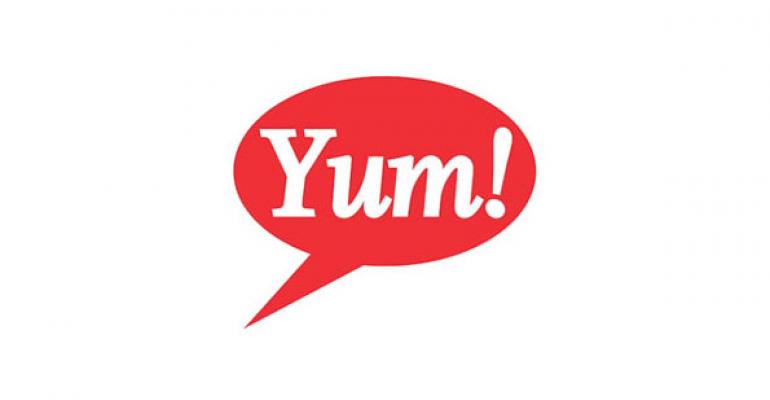Plummeting sales in China made 2013 a year to forget for Yum! Brands Inc., but at least one securities analyst is “increasingly confident” that the quick-service giant’s same-store sales and stock price will recover next year.
Sara Senatore, the restaurant industry analyst for Bernstein Research, upgraded the New York-based firm’s rating of Yum’s stock to “outperform,” from a previous classification of “market perform,” in a research note published this week that pointed to a strengthening Chinese market and Yum’s recent corporate realignment.
She noted that Yum’s weakness in China this year was specific to its flagship KFC brand, which dealt with negative publicity for the country’s supply of chicken and new fears of avian flu, making KFC’s troubles more transient than structural in nature. She added that slower economic growth in the country played a role, but “we see evidence that the industry backdrop could prove more benign going forward.”
RELATED
• Yum China same-store sales rise slightly in November
• Yum: China sales recovery unlikely in 2013
• More restaurant finance news
“Looking ahead, as Chinese growth and inflation begin to gather more strength, Yum’s recovery will likely occur in a more favorable macro environment that supports comps,” Senatore wrote.
Performance beyond China also should improve in 2014 as a result of Yum’s recent global realignment of its KFC, Pizza Hut and Taco Bell chains, she added.
“Outside of China,” Senatore wrote, “we believe the reorganization will better align incentives and could support modest upside to targets if brands are run with greater focus.”
Plenty of potential left in China
Same-store sales in Louisville, Ky.-based Yum’s crucial China division fell precipitously to start 2013, following a December broadcast on Chinese state television of a report questioning the safety of the country’s poultry supply. What little progress toward same-store sales recovery KFC had made was derailed in April, when new cases of avian flu were reported in Shanghai, eviscerating demand for chicken once again.
However, Yum’s sales in China have been trending upward since the 29-percent decline in April. The company reported a 1-percent gain in same-store sales in China in November. That month, KFC, which has about 4,500 locations in China, achieved flat comparable sales, while Yum’s second-largest brand in China, Pizza Hut Casual Dining, reported a 7-percent gain in same-store sales.
Senatore noted that KFC’s sales should accelerate the further out from the supply chain and avian-flu controversies the brand gets, especially since trends at Pizza Hut and McDonald’s in China hint at a slowly improving macro economy there. McDonald’s sales declines matched the trajectory of those for KFC this past year, but to a less severe degree because KFC bore the brunt of attention on the poultry supply, she wrote.
“But the data suggest that, beyond the poultry supply and avian-flu issues, weak consumer confidence and spending have also played a role in pressuring restaurant demand trends,” Senatore wrote. “Notably, both Yum’s and McDonald’s top lines appear to be on the same upward trend, a reflection that the industry is starting to emerge from the combined challenges of weak consumption and negative publicity.”
Once that fledgling recovery gains momentum, Yum would be well-positioned for long-term growth in China, both for KFC in the developing interior provinces and for Pizza Hut’s Casual Dining and Home Service formats, she noted.
“Given our view that [KFC] is not structurally impaired, we expect Yum to be able to maintain and perhaps moderately increase the number of KFC openings in coming years, even as the strong Pizza Hut brand continues to accelerate the pace of unit growth,” Senatore wrote.
She added that restaurant margins and investment returns are significantly higher for KFC locations in Tier 3 through Tier 6 cities in China’s interior, which would provide a hedge against margin compression in higher-cost, coastal cities like Shanghai in the future.
“Substantial” long-term growth opportunities remain intact for both Yum’s brands, Senatore estimated. She noted that the foodservice market in China could grow to $700 billion by 2017, with chain restaurants accounting for only 10 percent of total sales, compared with the 55 percent of total foodservice sales reported by chain restaurants in the United States.
Realigned for growth elsewhere
“While Yum’s share performance hinges on China,” Senatore continued, “we believe the rest of the business should continue to perform in line with expectations, with potential for upside from the recent reorganization.”
She specified that Taco Bell, the largest contributor of profit and sales growth in the United States, was “on solid footing and has a reasonable good chance of succeeding at the important breakfast daypart.”
Combining the U.S. system with the markets of the former Yum Restaurants International division to make three individual, global divisions for KFC, Pizza Hut and Taco Bell should “create the potential for better growth and profitability, as managers are compensated on the strength of each brand, rather than geographies,” Senatore wrote. Historically, the old alignment created incentives for Yum to grow KFC worldwide, often at the expense of Pizza Hut or Taco Bell.
The United States should be a stable market for Yum, particularly Taco Bell, she forecasted.
“The brand’s successes with Doritos Locos Tacos and creative marketing have helped drive comps over the last two years,” she wrote, “and we believe that continued good execution, along with expansion into new dayparts, could sustain Taco Bell’s top-line momentum in a slow-growing informal eating-out market.”
In the rest of the world, emerging markets are a key opportunity and favor Yum’s established capital-light franchising model, she added.
“We believe that a continued focus on a franchised model in fast-growing emerging markets makes the most strategic sense,” Senatore wrote. “Comps have been sluggish, but we anticipate that a revival of emerging-market demand growth will help sustain top-line trends over the long term, as the mix of Yum’s restaurant portfolio shifts.”
Yum operates or franchises more than 40,000 restaurants in more than 130 countries.
Contact Mark Brandau at [email protected]
Follow him on Twitter: @Mark_from_NRN

